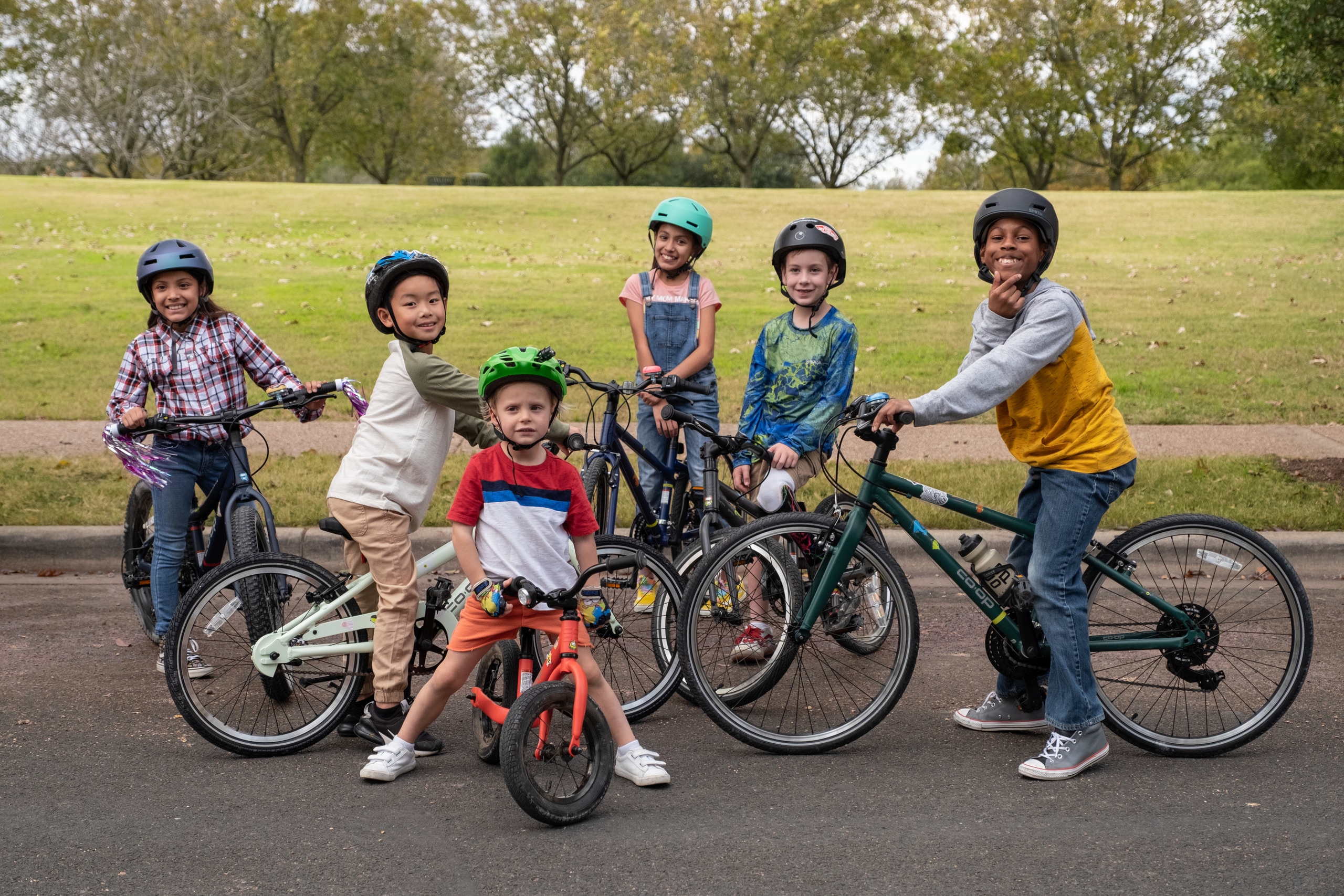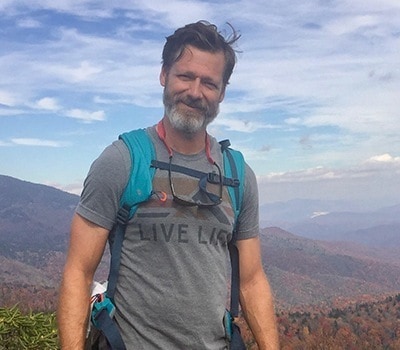Learning how to ride a bike is a defining moment in a child’s life. The freedom that comes with pedaling down the neighborhood is exhilarating. And you can help stoke that excitement early by getting your child into a kids‘ bike that’s right for them and encouraging that sense of freedom as the child grows and becomes more confident.
There are a lot of bike options out there, but which is best for your child? We asked our team of experts to weigh in on their favorites. There’s a bike for every kid, from toddlers learning to balance on two wheels for the first time to a ‘tween looking to shred dirt solo. So read on for our top bikes available at the co-op.
Best Kids’ Balance Bike
STRIDER 12 Sport Kids' Balance Bike
Recommended age 18 months to 5 years
Weight 6 lbs. 11.2 oz.
Wheel size 12 inches
If you want to instill confidence early, start kids off with the STRIDER 12 Sport. A balance bike ditches pedals for a more intuitive foot-driven system (think the Flintstones but with shoes). The company's best-selling 12 Sport allows toddlers as young as 18 months to scoot and glide on the bike by pushing off with their feet, giving them a little taste of freedom while laying down the foundation for solid biking skills. Gliding without pedals helps kids learn how to balance and steer and helps them transition more easily to pedaling.
"At under 7 pounds, this bike is so lightweight that my toddlers could steer and handle the bike with ease," says one of our editors. Both her sons learned on the same STRIDER, starting at age 2, first scooting and then later lifting up their feet and cruising. They easily moved on to pedals soon afterward and skipped training wheels entirely, she says. Features on the bike make it easy to grow with the child or pass it down between kids. For example, the seatpost and handlebars can be adjusted without tools so the bike can accommodate toddlers to kids about 5 years old. Another parent bonus: The EVA polymer tires remove worry about getting flats. Buy here.
Best Beginner Kids’ Pedal Bike
Co-op Cycles REV 12 Kids' Bike
Recommended age 2 to 5
Frame material Aluminum
Weight 15 lbs. 12 oz.
Wheel size 12 in.
Going from a balance bike to the first pedal bike is a big step for kids, some of whom struggle with the new system. But the REV 12 from Co-op Cycles makes that transition as smooth as possible by keeping some of the balance bike's user-friendly features. A low stand-over height and 12-inch wheels boost confidence, and brakes and pedals are introduced in a nonintimidating way. Braking can be a tough skill for new riders, especially coming from balance bikes where they learn to put their feet on the ground to slow down. But the rear coaster brakes on the REV 12 are intuitive and easy to pick up (just pedal backward). And REI places a "parent handle" under the seat, that Ranulfo "Moon" Villalobos loves. "It allows children to have just a bit more confidence to pedal without training wheels," says Villalobos, a bike mechanic in the Brookfield, Wisconsin, REI store.
The REV 12 also has a full-length chain guard to help keep pants from getting tangled, and training wheels that are easy to take on and off. Each bike comes with a sticker pack, so your kid can customize the frame. Like all REI Co-op bikes, the REV 12 comes with a year of free adjustments, free in-store assembly and, if you're an REI Co-op Member, you get free flat tire repairs and 20% off bike shop services.
Best 16-inch Cruiser Bike
Electra Sprocket 16" Kids' Bike
Recommended age 5 to 8
Frame material Aluminum
Weight 20 lbs.
Wheel size 16 in.
The Electra Sprocket performs as well as it looks, with an aluminum frame that can handle abuse and tires built with Kevlar® Guard casing to help prevent flats. Curved handlebars and a lower seat for laid-back riding put comfort first. Meanwhile, the patented Flat Foot Technology® allows a kid to be seated on the bike in a more upright position and still plant their feet on the ground when stopped. Many bike designs lift the rider so high off the ground they have to lean over to touch the ground with their tippy toes. Electra's design helps reduce a young rider's fear of tipping over. Meanwhile, the addition of a handbrake and a coaster brake allows your kid to start learning the nuances of handbraking while still having the safety net of a coaster brake. And if your child is wavering between riding with or without training wheels, the stabilizers on the Electra can be removed and reattached without tools on the fly.
Multiple reviewers have noted that all these design features make the Sprocket the perfect bike for kids who have reservations about riding. They're also impressed that the bike delivers a smooth, stable ride.
Best 20-inch Kids Bike
Co-op Cycles REV 20 Kids' Bike
Recommended age 6 to 10
Frame material Aluminum
Weight 20 lbs. 1.3 oz.
Wheel size 20 in.
If your kids are spending most of their time riding around the neighborhood, why not get them a one-speed bike that's designed for that riding? The Co-op Cycles REV 20 is built to help make your child more comfortable while riding smooth surfaces. Most notable are the 2.25-inch-wide tires, which deliver better control than the skinnier tires found on most bikes this size. The brake lever also adjusts on the hand grip, making braking easier for small hands. A BMX-style handlebar offers thick grips that cover the entire bar ends. It even comes with a kickstand that you can attach after you remove the training wheels.
Like the Electra Sprocket, the REV 20 has a combo of coaster and grip brakes, which one REI marketing director says helped his 7-year-old ease into handbrakes. He also appreciates the wider tires that can handle many road conditions. He adds: "I like the simplicity and the curation of the components," as well as knowing that he could trade it in through the REI used gear program.
This is an ideal bike for neighborhood streets and greenways, and can even handle some light gravel roads and dirt surfaces. If you're looking for your kid's first trail bike, check out the Cannondale Cujo+ below. If you're not sure about adjusting the bike for your kid's height, take it into your REI bike shop.
Best 26-inch Kids' Bike
Cannondale Trail 26 Kids' Mountain Bike
Recommended age 9 to 13
Weight unavailable
Frame material SmartForm C3 alloy
Wheel size 26 in.
Many adult bikes have 26-inch wheels, and it can be tempting to make the leap to an adult steed when your kid grows out of their 24-inch bike. But the Trail 26 by Cannondale gives you a middle-ground option with a larger tire size to fit their growth spurt, but a kid-appropriate frame size and components. It's the ideal bike for your kid as they begin exploring terrain beyond the paved greenway and neighborhood streets.
Again, Cannondale uses the light but durable SmartForm C3 alloy to maximize the weight-to-performance ratio. The Trail 26 also has a Suntour suspension fork with 63 millimeters of travel, mechanical disc brakes for sure stopping power and internal cable routing, which is a detail usually found on higher-end adult bikes that keeps the cables hidden so the rider can't snag or pull them.
REI bike mechanic Villalobos appreciates the components that Cannondale uses for the Trail 26. "I love that this bike comes with a front suspension that is perfect for hitting all riding conditions, and the mechanical disc brakes and 1 x 8 drivetrain allow your rider to have control in any situation," he adds.
Buying Advice
Consider these factors when buying a bike for your kids.
What size bike does the child need?
Kids’ bikes are separated by wheel size—12-inch-diameter wheels like the STRIDER 12 Sport Kids’ Balance Bike for the smallest humans to 24-inch wheels for big kids. (Adult bikes start at 26-inch wheels and are measured based on the frame size). Age factors into the buying decision too, but there’s a wide range of appropriate ages for each size. Your child could be 5 years old and riding a 12-inch bike or a 20-inch bike, depending on height and leg length. In short, pay more attention to how your child fits on the bike than the recommended age range. Can they reach the handlebars and put their feet flat on the ground while sitting on the seat? Or are their knees in their chest when they pedal? Learn more in How to Choose Kids' Bikes.
Where will they ride?
The majority of bikes for children and adolescents are built to handle many surfaces, from concrete to dirt trails. That said, there’s still some specialization once you enter “big kid bikes” in the 20-inch to 24-inch wheel range. Choose a bike by the type of terrain your child will ride most of the time. If you’re surrounded by greenways and sidewalks, a more recreational bike like the Co-op Cycles REV 20 is a good option; it will be lighter with skinnier tires and a rigid fork. If you’re hoping to raise a singletrack shredder, look for mountain bikes with wider tires. These bikes will be a little heavier, but they’re built to roll over uneven terrain and come back for more.
A key tip from our experts: To keep your child confident and having fun, increase the size of the bike incrementally as your child grows. Introducing a bike that’s too large too soon can frustrate a young rider and turn them off from riding. And nobody wants that.
Remember: Safety is your responsibility. No online article or video can replace proper instruction and experience—this article is intended solely as supplemental information. Be sure you’re practiced in proper techniques and safety requirements before you engage in any outdoor activity.
Our process
We asked our team of retail specialists, bike techs and employees at REI to detail their favorite picks for kids‘ bikes. They reported back with their top choices for a wide range of children, from toddlers who can barely say the word “bicycle” to big kids starting to shred singletrack.






![REV 12 Kids' Bike [Training wheels off (BONDI)]](/media/86064914-21cb-47e1-b496-75e8cb007cba/?size=440)



![Sprocket 16" Kids' Bike [3/4 front view (Seafoam)]](/media/2e416b98-60ea-4b7d-b59a-e30fbf67e0da/?size=440)

![REV 20 Kids' Bike [Training wheels off (Four Leaf)]](/media/727de967-2ab5-484f-99f8-d941f98753a5/?size=440)






